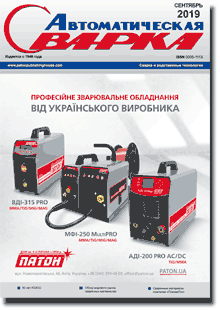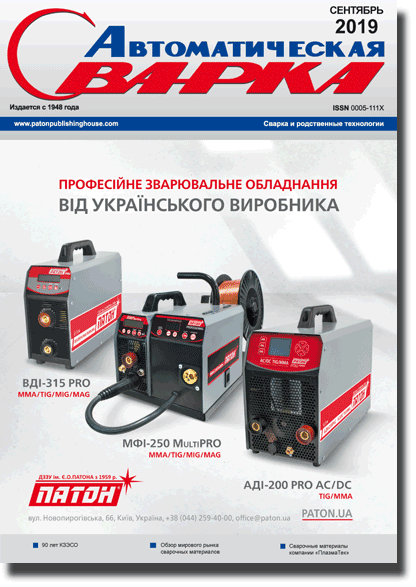| 2019 №09 (09) |
DOI of Article 10.15407/as2019.09.01 |
2019 №09 (02) |

Avtomaticheskaya Svarka (Automatic Welding), #9, 2019, pp. 7-13
Microstructure of VT20 titanium alloys produced by method of layer-by-layer electron beam fusion using domestic powder materials
V.M. Nesterenkov1, V.A. Matveychuk1, M.O. Rusynik1, T.B. Yanko2, A.E. Dmitrenko3
1E.O. Paton Electric Welding Institute of the NAS of Ukraine. 11 Kazimir Malevich Str., 03150, Kyiv, Ukraine. E-mail: office@paton.kiev.ua
2PJCS «Titanium Institute». 180 Soborny Ave., 69035, Zhaporozhye, Ukraine. E-mail: titanlab3@ukr.net
3NSC «Kharkov Institute of Physics and Technology». 1 Akademicheskaya Str., 61108, Kharkov, Ukraine. E-mail: dmitrenko@kipt.kharkov.ua
Samples of products of domestic non-spherical powders of VT-20 titanium alloy were obtained by method of electron beam 3D-deposition. Microstructure of deposited metal is a porous-free, fine-dispersed and uniform along the whole surface of section. It is acicular titanium α’-phase with small content of β-phase. Sample microhardness is from HV 3960 to 4150 MPa. Uniform distribution of alloying elements and decreased content of aluminum due to its volatility in deposition was noted. Presence of insignificant porosity and increased roughness on part edges was determined. The methods of their elimination were outlined. Ref. 10, Tabl. 1, Fig. 11.
Keywords: additive technologies, titanium alloy, electron beam, deposition, structure, microhardness
Received: 12.06.2019
References
1. Nesterenkov, V.M., Matviichuk, V.A., Rusynik, M.O., Ovchinnikov, A.V. (2017) Application of additive electron beam technologies. The Paton Welding J., 3, 2-6. https://doi.org/10.15407/tpwj2017.03.012. Yanko, T.B., Ovchinnikov, A.V. (2018) Titanium in additive technologies. In: Construction, materials science and machine building: Starodubov Readings, 217-222 [in Russian].
3. Nesterenkov, V.M., Matviichuk, V.A., Rusynik, M.O. (2018) Manufacture of industrial products using electron beam technologies for 3D-printing. The Paton Welding J., 1, 24-28. https://doi.org/10.15407/tpwj2018.01.05
4. Nesterenkov, V.M., Khripko, K.S., Orsa, Yu.V., Matvejchuk, V.A. (2018) Electron beam technologies in aircraft construction. Materials Science: Achievements and prospects. In: 2 vol., Vol. 2, ed. By L. M. Lobanov. Kyiv, Akademperiodika, 192-221 [in Ukrainian].
5. Matviichuk, V.A, Nesterenkov, V.M., Rusynik, M.O. (2018) Application of additive electron-beam technologies for manufacture of metal products. Electrotechnica & Electronica E+E, 3-4, 69-73. https://doi.org/10.15407/tpwj2018.01.05
6. Mahale, T.R. (2009) Electron beam melting of advanced materials and structures: Ph.D. dissertation, North Carolina State University, NC, US.
7. Gaytan, S., Murr, L., Medina, F. et al. (2009) Advanced metal powder based manufacturing of complex components by electron beam melting. Materials Technology, 24(3), 180-190. https://doi.org/10.1179/106678509X12475882446133
8. Zäh, M.F., Lutzmann, S. (2010) Modelling and simulation of electron beam melting. Production Engineering, 4(1), 15-23. https://doi.org/10.1007/s11740-009-0197-6
9. Muth, T.R., Yamamoto, Y., Frederick, D.A. et al. (2018) Causal factors of weld porosity in gas tungsten arc welding of powder-metallurgy-produced titanium alloys. JOM, 65(5), 643-651. https://doi.org/10.1007/s11837-013-0592-5
10. Price, S., Cheng, B., Lydon, J. et al. (2015) On process temperature in powder-bed electron beam additive manufacturing: Process parameter effects. J. of Manufacturing Sci. and Eng., 136, 061019. https://doi.org/10.1115/1.4028485
The cost of subscription/purchase order journals or individual articles
| Journal/Currency | Annual Set | 1 issue printed |
1 issue |
one article |
| TPWJ/USD | 384 $ | 32 $ | 26 $ | 13 $ |
| TPWJ/EUR | 348 € | 29 € | 24 € | 12 € |
| TPWJ/UAH | 7200 UAH | 600 UAH | 600 UAH | 280 UAH |
| AS/UAH | 1800 UAH | 300 UAH | 300 UAH | 150 UAH |
| AS/USD | 192 $ | 32 $ | 26 $ | 13 $ |
| AS/EUR | 180 € | 30 € | 25 € | 12 € |
| SEM/UAH | 1200 UAH | 300 UAH | 300 UAH | 150 UAH |
| SEM/USD | 128 $ | 32 $ | 26 $ | 13 $ |
| SEM/EUR | 120 € | 30 € | 25 € | 12 € |
| TDNK/UAH | 1200 UAH | 300 UAH | 300 UAH | 150 UAH |
| TDNK/USD | 128 $ | 32 $ | 26 $ | 13 $ |
| TDNK/EUR | 120 € | 30 € | 25 € | 15 € |
AS = «Automatic Welding» - 6 issues per year;
TPWJ = «PATON WELDING JOURNAL» - 12 issues per year;
SEM = «Electrometallurgy Today» - 4 issues per year;
TDNK = «Technical Diagnostics and Non-Destructive Testing» - 4 issues per year.





